[Click here to go forward to Chapter 7]
If you read Joseph Rock's article about the "Glories of the Minya Konka", you will notice much of it is actually devoted to his getting there - and in particular to the arduous journey he made from Lijiang across the remote canyon of the Yalong river, which he describes as being comparable to the Grand Canyon of Colorado.
Crossing the enormous 9,000-foot deep gorge of the Yalong river took him "five terrible days". After descending and then climbing out of this enormous gorge, he eventually reached a mountain pass on the eastern bank called Wadzanran, where the mountain scenery left him awestruck:
"The scenery hereabouts is overwhelming grand. Probably its like cannot be found elsewhere in the world. Where Muti Konka rears its eternally snow-capped crown 19,000 feet into the sky, the Yalung flows 12,000 feet below..." he wrote.
The pictures accompanying the article seemed to back up his claims, showing a narrow ribbon of river enclosed deep within a wooded canyon, and a maze of mountain ridges receding to the horizon.
"A scenic wonder of the world, this region is 45 days from the nearest railhead. For centuries it may remain a closed land, save to such privileged few as care to crawl like ants through its canyons of tropical heat and up its glaciers and passes in blinding snowstorms, carrying their food with them..."
I was intrigued by these claims of sublime scenery and wanted to be one of the 'privileged few' to make the journey to the Yalong canyon. However, as with Muli, I could find no mention of "Muti Konka" or the canyon on any modern maps or in any guidebooks. Joseph Rock seemed to have been right. It had become a closed land.
One of the main reasons why the canyon had remained unvisited was that following the Communist revolution in 1949 the areas around Jiulong and Muli had become officially 'closed areas' and remained off limits to foreigners right into the 1990s. To visit them would require a special permit usually only granted to official groups escorted by a Chinese government minder. Another reason was that there simply wasn't a decent map to be had of the area.
So, while I remained curious about the mountain called Muti Konka through the 1990s, it remained in the back of my mind as I explored other more easily accessible areas of south west China that I had read about in other articles written by Joseph Rock.
Then in 1997, on a visit to London, I popped into the Royal Geographic Society library near the Albert Hall to see what they had in the way of maps of Yunnan and Sichuan. To my delight, I found they had sets of Rock's large, hand-drawn maps of his travels, which gave much more detail than the miniature sketches reproduced in the National Geographic.
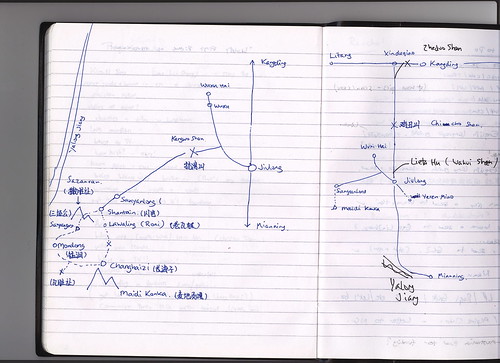
Armed with a photocopy of Rock's maps - which were as big as a dining table, I started making plans to the botanist's footsteps across the Yalong. I had already been deterred by the massive scale and the sheer gradients of the trackless landscape around Muli, so I decided to make an attempt to reach the Yalong from the north east instead, starting from Kangding. A modern Chinese map showed there was now a road running close to the Yalong from this direction, emanating from the town of Jiulong, a day's drive south of Kangding.
And intriguingly, this road corresponded with the route taken by Joseph Rock in 1929, through a valley called Yangwe Kong.
I wanted to visit this valley because Rock had described the Yangwe Kong valley as being completely isolated, even by the already remote standards of the Tibetan borderlands of the 1920s.
"No outlook in any direction! Here people live and die without the slightest knowledge of the outside world. How oppressive to be buried alive in these vast canyon systems! Or are they happier for it?"
This sounded like it could have been the inspiration for the Shangri-La myth. After reading this I was curious to know - would the modern inhabitants of the Yangwe Kong valley still be as isolated?
Comparing maps, I noticed that names of many villages mentioned by Rock in the valley were similar to those marked on the modern road: could the place marked 'Sedjuron' on Rock's map be the 'Sanyanlong' on the modern Chinese map? Modern 'Diwan' was in roughly the same place as Rock's 'Deon'. And the riverside hamlet of 'Mutirong', where Rock crossed the Yalong by dugout canoe, tallied with the modern Chinese settlement of Maidilong (麦地龙).
The best option to get to Jiulong seemed to be via Kangding in the north. However, my first tentative attempt to get there in the spring of 1998 - after a trip to Gongga Shan - was thwarted by the impassable condition of the Kangding to Jiulong road. Floods and landslides had washed out the dirt road, leaving it strewn with a mixture of silt, boulders and the twisted branches of uprooted trees and bushes.
In October 2004 I made my next attempt. Kangding was now easily reached from the Sichuan capital of Chengdu (and its international airport) in a day, thanks to a tunnel that had recently been bored directly through the 4500 metre high mountain of Erlang Shan.
The ease of access had transformed Kangding into the something of an alpine resort.
By 2004 Kangding had developed into a bizarre mixture of Tibetan market town and hive of Chinese consumerism. Its high street straddled the raging torrent of the Dardo river, flowing fast and cold right down out of the mountains. The river was flanked by colourful modern retail outlets selling everything from Nike sports gear to cream cakes.
Khampa nomads and Tibetan pilgrims were still in evidence in town, rubbing shoulders with Han Chinese girls sporting the latest Nokia mobile phones and Hello Kitty accessories. On the main town square teenage Tibetan monks leapt around in their crimson robes to slam basketballs though hoops, without attracting a second look from the well groomed staff in the marble lobby of the four star hotel.
In a Body Shop-style beauty store I saw a tough looking Khampa Tibetan man with red thread woven into his hair dutifully following his wife around to peruse jojoba oil and facial scrubbing sponges. There was an internet bar where a dozen teenagers played online war games, completely absorbed in their headphone-cocooned virtual battlefield as electronic American accents clamoured "Fire in the hole!".
I visited the Catholic church again, the gaudy building with a red façade and blue spires facing onto the river. They were still using the curling old missals from the 1930s.
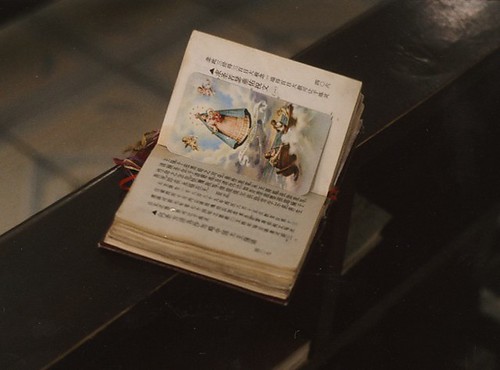
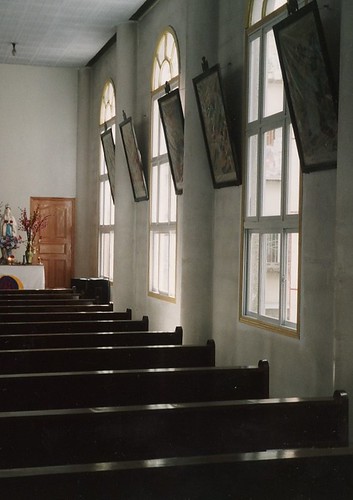
Across the street, the Qingzhen mosque served as a focal point for the meat market: Hui Muslims had traditionally been Tibet's butchers, taking on the task that the life-respecting Buddhists could not.
But Kangding still had some of its old streets. There were still rickety old wooden houses in the centre of town, and still the old market for raw yak meat and a wide array of vegetables and fruit.
I spent a lonely night at the Black Tent Hotel, attached to the Anjue Si Buddhist monastery. I re-read Rock's article from 1929, when he had travelled up in the opposite direction, towards Tatsienlu (Kangding) from his home 'base' at Nguluko near Lijiang.
With his usual large entourage of Naxi assistants, cooks and Tibetan bodyguards, he made his way north, first to Muli, where he had previously befriended the fat ruler of the 'kingdom' of Muli on his travels to this "Land of the Yellow Lama", and where he had also rested while on his expedition to the Konkaling mountains.
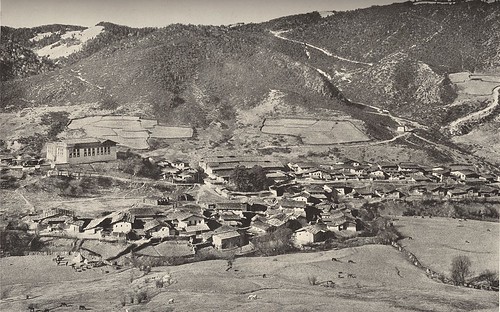
On this occasion, he found that the Muli king was in residence at Kulu monastery - a lesser one of the three main Muli monasteries. Rock stayed for a week at Kulu, waiting for better weather, and in his article he recounts some of the strange ways of this Tibetan potentate. They shared a meal of fried eggs, bits of mutton, Chinese noodles and a bowl of sour yak cream "of which the king is inordinately fond".
Rock spoke to the king in Chinese, which was translated into Tibetan by the king's secretary. Rock was bemused by the hapless assistant, who would have to wait by the king's side for hours with his head bowed in deference. When Rock took pity on him, the king swept some food scraps off his plate and gave them to his servant "as if he were feeding his favourite dog".
Rock also makes a coy reference to the king's weird practice of having his stools moulded into pills, and these Royal dropping then being given to the Muli peasants as medicine! Even more bizarre is the revelation that the Muli king had the mummified remains of his uncle [who had died 60 years previously] kept in a shrine in the dining room.
"Thus royalty in Muli is never lonely, but always has company, although not of a very talkative type!" quips Rock.
By April 1929 the weather had improved, and Rock set off north from Muli accompanied by an additional 10 Pumi [Hsifan] soldiers from Muli, and a Muli lama. His long journey to the Minya Konka peaks and Kangding took several weeks, starting with an arduous trek of several days through alpine meadows and fir forests to the edge of the Yalong canyon.
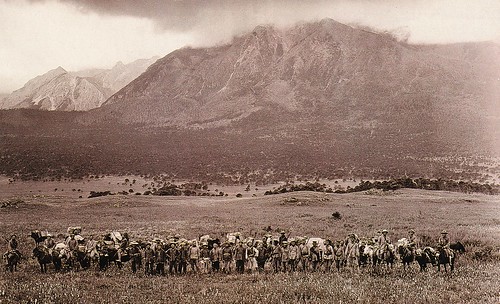
The river marked the eastern boundary of Muli territory, and here the trail descended 6000 feet in steep zig-zags to the Yalong, which flowed at an altitude of 7300 feet.
It was at this spot that Rock first caught sight of the isolated mountain peak of Muti Konka (Maidi Gangga, 麦地贡嘎), rising to a height of about 19,000 behind the village of Mutirong on the far side of the river.
But first, he had to cross the canyon. After descending into its depths, he and his caravan were ferried across the river by locals in a pair of dugout canoes. The villagers would not have helped him, had it not been for the presence of the Muli lama whom Rock had brought along as a guide.
The local peasants feared this representative of their ruler, cringing and bowing their heads in his presence. Across the river, Rock rested in a flea-ridden chapel before setting off to climb out of the gorge and cross the Wadzanran pass en route to Chiulung (modern day Jiulong).
It was inhospitable country. In some parts, the trail was too steep even for loaded mules, and the loads had to be carried by Tibetan villagers for three days. There was neither water nor grass for the animals to feed on. Everything had to be portered up from the bottom of the gorge. It took him five gruelling days to get across the Yalong, and when he reached the top edge of the canyon on the far side he marvelled at how much effort was needed to travel such a short way:
"Where Muti Konka rears its eternally snow-capped crown 19,000 feet into the sky, the Yalung flows 12,000 feet below. From the Wadzanran Pass I looked back to Reddo, only a few miles as the crow flies and yet the drop and climb had required five terrible days!"
Oddly, however, Rock provides no photograph of the Muti Konka peak he describes in such dramatic terms.
After crossing the Yalong river and ascending through mountainous terrain on the eastern bank, Rock rested at the small town of Jiulong. He then had to cross another high pass, the Chiprin, [now known as the Jizu Shan pass] to the north, to reach Kangding and the Minya Konka range.
Seventy five years later, in 2004, I was about to take the 7am bus in the opposite direction, from Kangding to Jiulong and the unknown.
In the early morning chill of October 13th, our bus climbed out of the damp mist of the Kangding river valley and burst out into sunlight at the Zheduo pass, at 4280 metres.
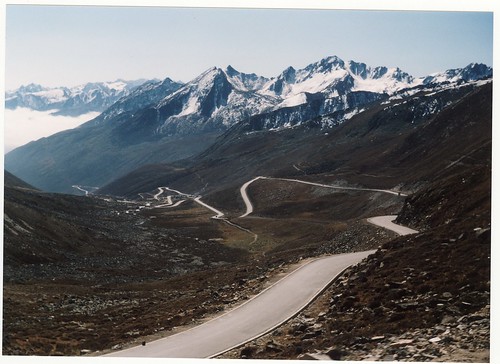
The pass was marked with a cairn festooned with red, green, yellow and blue prayer flags, white Tibetan scarves and hundreds of printed sheets bearing the Tibetan script Om Man Padme Hum. We had entered the cultural realm of Tibet.
This potholed road was the main Sichuan-Tibet highway, and most of the traffic was headed to the next town of Litang and perhaps beyond to Barkham and eventually Lhasa.
After a brief mid morning stop near Xinduqiao, we branched off southwards. The scenery was immediately very different. The road followed a foaming turquoise river through a valley of golden brown hills that reminded me of Otago in New Zealand's South Island.
In place of the utilitarian and often shoddily built Chinese buildings, there were now very solid H-shaped Tibetan farmhouses with flat roofs. These two storey structures with their white-edged, T-shaped window frames and flags flying from the roof looked like forts.
Further south, the valley deepened and the steep hills were forested with pines, oak and birch trees, giving a pleasing variety of autumnal colours, from green, to yellow to red. At one point we passed a lamasery that had high stone watch towers, similar to those portrayed in Joseph Rock's article. The few people we saw by the wayside were all Minya Tibetans, in traditional dress with coloured threads woven into their hair.
As we bowled along under the mid morning sun the sublime scenery contrasted with ridiculous onboard entertainment. The TV at the front of the bus played video clips from Indian MTV, on which Bollywood-inspired dance productions were accompanied lyrics such as "I'm so lonely in my life/ I want to have you as my wife"
To reach Jiulong the bus had to cross what Rock described as the Chiprin La, one of the highest passes on his journey. I anticipated this section with some trepidation: on Rock's journey [when there was no road] he had crossed the pass with great difficulty during a blizzard with his 20-strong mule caravan on his way to Kangding.
"As we ascended, the snow increased in depth and the blizzard in fury, for we were now above the timber line. We could see nothing but a purplish white wall and I seemed lost in a whirling mass of white. Up and up we climbed until finally I saw through a haze of snowflakes a few sticks which denoted an obo or cairn and hence the summit. Never did I exclaim more heartily with my Tibetans "Lha Rgellah ! Lha Rgellah!" ("The Gods are victorious", the accustomed shout of every Tibetan on a pass."
On the modern map the pass was described as the Chizu Pass, and it proved to be something of an anticlimax : a barren gap in the bare hills, ascended by a snaking road over a treeless landscape.
We paused at the top for a minute to allow a young Chinese mountain biker to get out and prepare for his freewheeling descent to Jiulong.
Rock wrote: "The Chiprin pass proved to be 16,000 feet in elevation. Our descent was very difficult. Men and beasts and loads were many times catapulted into the snow, some of us sliding in a snow bank up to our necks ..."
After crossing to the southern side of the Chizu pass the scenery appeared greener, and the climate somewhat milder. And instead of the blockhouse-like Tibetan houses of the Minyak Tibetans, the Tibetans of Jiulong county had more conventional stone-built dwellings with Chinese-style tiled roofs. As we neared Jiulong town the building took on a grim appearance due to their construction with sooty-coloured local stone. They reminded me of the pollution-blackened buildings of northern English industrial towns.
By mid afternoon our bus had rolled into what had been the town of ‘Chiulong’ where Rock had rested for several days after his arduous crossing of the Yalong and its canyons. He had described it as a ‘scattered hamlet’ with a friendly Chinese magistrate in residence "who could endure his post only by sleeping from one inebrious state to the next carousal".
At Jiulong, Rock also mentioned a collection of stone watchtowers called Taputzu (Or Dapuzi), made unstable by earthquakes and balanced precariously on the hillside. He wrote in exasperated terms about how the local population lived at the base of the towers, apparently unconcerned by the threat of being buried alive should they collapse.
Dapuzi Hill, Jiulong 1929 (Joseph Rock)
Dapuzi Hill, Jiulong 2004
The modern day Jiulong seemed a typical small Chinese town of concrete apartment buildings mostly built in the ubiquitous style of white tile and blue glass. As a nod towards local sensibilities, some of the newer buildings were of the latest mock-Tibetan style, with imitation wooden window frames and joists. Jiulong was basically a one street town nestled in a steep grassy valley, with a large hotel, the Longhai Dajiudian, at the top end of town overlooking what passed for a town square. The main street thronged with Tibetans and Yi people, many dressed in their traditional capes and headwear.
There were also Han Chinese in more contemporary clothing, sporting mobile phones and looking like Chinese anywhere.
My plan was to make a low-key approach to visiting the Yangwe Kong valley, perhaps hiring a jeep or horses to get there. But a Chinese I met on the bus, a Chongqing TV reporter called Yang Shi, had other ideas. After a late lunch of greasy noodles, he led me straight to the five-storey Communist Party office and took us up to the fifth floor to seek out the local party leaders to seek "permissions".
The interior of the building reminded me of the East German Stasi HQ that I had recently visited on a trip to Berlin. We passed committee rooms where within I glimpsed groups of people smoking and drinking tea. With my backpack and hiking boots I expected to be challenged and thrown out at any moment. Instead, we were greeted with bemused respect.
"What does the foreign friend want?" everyone asked.
On the fifth floor we were welcomed into the office of Mr Gao Linzhong, the head of the Jiulong county propaganda department. A small man, he looked a little like Kim Jong Il, but his manner was boisterous and down to earth.
He ushered me into his executive leather chair where I sat awkwardly, feeling like I was in the headmaster's office, looking at the picture of Mao Tse Tung sellotaped to the wall alongside maps of China and the world. Otherwise the furniture consisted of a large pine desk, a watercooler and a pot plant. After serving us green tea in paper cups, he perched on a stool and perused some of the old photographs that I had brought along - taken by Rock of their local area and people. I told him about Rock's visit to the Jiulong area, and description of it as a "scenic wonder of the world". That seemed to get his attention.
As he flicked though the pictures, his interest grew, and he started to comment on them:
"The local Yi people still wear this kind of jacket ... hey, you can only find that kind of old gun round these parts ... and that looks like ..." He stopped and suddenly stood up to shout someone's name out of the window. "Wang Qi! Wang Qi! Come and see this!"
A short time later a burly Tibetan man in Chinese clothing came into the room, and started to look through the photographs. He stopped at one taken of a group of Tibetans stood in front of some old wooden shacks. He peered more closely and said:
"This is Mundon. And that man on the right is my grandfather."
Our conversation continued over a lavish dinner at a local restaurant. Wang Qi told me his Tibetan name was Zago Tsering, and he was now the director of education for Jiulong county. He had been brought up in the Yangwe Kong valley and remembered the tales his grandfather had told of a foreigner passing though. But he had never known who "Rock" was. After several toasts to friendship and health, Zago announced he could take me to Mundon and combine a "fact finding tour" with a visit to his family. We would also try to see if we could get to Muti Konka, which he believed was the mountain visible from a point high above his home village.
The next few days were a strange mix of frustrating inactivity and occasional bursts of enthusiasm and announcements of our imminent departure. We were invited to numerous banquets at which we were toasted with beer, baijiu (white spirits) and tea. We were urged to eat numerous dishes containing what appeared to be beaks, claws and tentacles. It rained and Jiulong felt grim.
We seemed to meet all the local dignitaries, and many visiting officials from the Sichuan capital of Chengdu. At each one the Propaganda department head Mr Gao would say: "Let our Australian friend tell us what Mr Rock wrote about this area". And he would repeat Rock's phrases about the Muti Konka area being a scenic wonder of the world, and there being nowhere else in the world with scenery quite like it.
"That's our new tourism slogan!" he would enthuse.
"Look at Shimian county down the road - they get thousands of tourists and what have they got? A few waterfalls and some alpine frogs! According to our foreign friend we've got 'the best scenery in the world ..."
"And our frogs are bigger than theirs," added the Assistant Party Secretary, sat next to him.
We drank endless cups of tea with officials who I presumed would have some input to our forthcoming trip. But whenever we asked about setting off, the answer was always "probably tomorrow".
In frustration I made some trips to other local attractions. Up a dirt road some 25km to the north west of Jiulong was Wuxu Hai (lake), situated at the foot of some grey limestone peaks known as the 12 Beautiful Daughters.
Joseph Rock had passed through this area, but despite his reputation for meticulous recording of every compass bearing and minor feature, he did not comment on the picturesque lake.
Wuxu Hai lake was an idyllic spot, a 1km expanse of water surrounded by peaks and wooded hillside. I spent spend a pleasant day by the lakeside watching the weather changing around the peaks further up the valley. The local Tibetans who lived in log cabins around the shore took me to a waterfall further up the alpine valley, beyond which there was said to be hot springs and a sacred lake, Tian Chi, six hours further into the mountains.
In the evening, I stayed in one of the local log cabins, squatting around the kitchen fire, talking to the wife of Mr Xu, the village leader, and their blind son who was surprised to find he was talking to a foreigner. As he stoked the wood-fired cooker, I wondered how he managed to avoid injury in the cramped interior.
While we talked, his wife busied herself making butter tea and turning yak's milk into butter using some strange manual separator with a crank handle. Life in this rural part of the China-Tibet borderlands was still basic and close to nature. No electricity or running water. Everything was done by hand, and it brought to mind our old nursery rhymes about sitting in corners eating curds and whey.
Returning to Jiulong I made a visit to the Yeren Miao or "Wild Man (Yeti) Temple" a few kilometres to the south east of the town, along another bumpy farm track.
Situated in a cave half way up a cliff, despite its name this temple did not refer to a Yeti. The local legend was that statues and temple structures had appeared in the middle of the night in the cave, and these had been attributed to a Wild Man. The small temple contained relics that purported to bear footprints and handprints of the Wild Man.
I stayed a few hours at this lonely spot, browsing around the wooden temple and talking to the caretaker. Interestingly, the temple had on display a copy of a photograph of a monk taken by Joseph Rock in 1924. Rock described the monk as the young abbot of a monastery at Zuosuo, near Yongning.
Into the Yangwe Kong valley
"Zou Ba!" (Let's Go!) were the words of Zago on a bright Monday morning. True to his word, there was a Landcruiser parked outside the hotel, loaded with supplies for a family visit. In the back was a food mixer - the modern Tibetan's way to prepare butter tea - packs of dried noodles, and two large leaky containers of very volatile smelling liquor.
Also crammed inside the car were his wife Pema and their 20-year-old daughter Namu, a medical student back from her studies in Chengdu. She had dyed bronze hair, and a face like a serene Tibetan Buddha, which only made her relentless teasing of her father seem all the more incongruous.
As we set off up the road to the Yangwe Kong valley she giggled conspiratorially with her mother.. "A-ba - will they have a horse big enough to carry you up the hill?" she mocked. Later on she hummed songs and practised counting up to a hundred in the local Tibetan dialect: "Dali, Nali, Songli ..."
It didn't seem like we were setting off on an expedition to find a lost mountain. "Have you got my handbag? asked Pema in the back. "I've got something special for Aunty Mera in it"
The road initially followed the familiar dirt track north west towards Wuxu Hai, but after a few kilometres we branched off westward, up a much rougher track. Above us towerred a great rocky peak that was marked on Rock's map as "Black Limestone Peak" - so he had been this way.
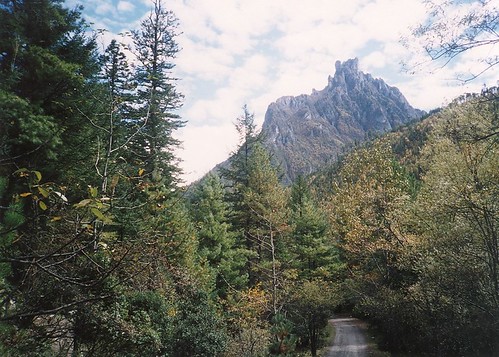
The side road was much worse. Almost immediately we were being tossed around inside the car - I clung on tightly to the handles on the doorframe, but still could not avoid being bumped and bruised as the Landcruiser rocked and bounced over potholes, ruts and boulders.
In this way we ascended a pine-forested valley up to what Joseph Rock called the Druderon Pass. It was a lonely place - fir trees and some old water races diverted to turn water wheels in little shacks, presumably for grinding corn. But no sign of human habitation.
After a tortuous twisting ascent on the switchback dirt road we neared the pass and rose above the tree line. The landscape might have been in Scotland - brown moorland and an alpine tarn - and the imposing shouldered wedge of a grey limestone peak, which Zago told me, was Kangwo Shan. This was another mountain pass that Rock had crossed with great difficulty:
"We had already been informed at Deon Gomba, a tiny monastery recently looted by the Konkaling bandits, that the Druderon although not high, was snowed in and hence impassable. With an exhausted caravan it seemed hopeless ..." he wrote.
"The following morning when I looked out of my tent and beheld our camp almost buried and our animals shivering in the cold, I really feared for the shelterless men who had stayed behind with the exhausted mules. I also feared for the two of our soldiers who had braved the pass the evening before. They were to go to [Jiulong] to bring us yaks, which could plough a trail through the deep snow and help us across. The snowstorm continued for a short time; then the sun appeared. This was the last day of April, 1929."
Again, we were lucky to have clear weather and a good driver for our crossing of the Druderon Pass.
Over the other side of the pass we halted briefly and the view was of wave after wave of receding hills. Somewhere on the distant horizon, Zago pointed out a hill -that's Mengdong, where we are going today, he said.
We descended into the Yangwe Kong valley and the condition of the zigzag road became deteriorated even further. On some sections landslips meant we had to get out of the car to allow our driver Puntsog to negotiate them alone.
Some way down there was a cluster of stone buildings called Diwan, but there was no longer a monastery called Deon Gomba, said Puntsog. When I mentioned that Rock had said the pass also formed an ethnic divide between the Tibetans and the Hsifan tribe, Zago visibly winced.
"Hsifan is a derogatory term. Actually the people on this side of the pass are Pumi. We are similar to the Tibetans but our language is different to Lhasa Tibetan dialect," he explained.
I was curious to see this valley that Rock had claimed to be so oppressive, whose inhabitants he believed to be "buried alive inside vast canyon systems".
Yet as we bumped and rocked down the Yangwe Kong it did not seem particularly oppressive. In fact it had rather a pleasant climate and outlook. Under sunny skies we passed small settlements called Shigen and Bongbongchong where the yards and fields were planted with maize. There were apple, orange and peach trees, while pigs and goats roamed freely and a river flowed green and clear beside us.
It could almost have been an isolated valley in Europe. The local houses were of simple Tibetan style, made of stone but with practical sloped roofs of Chinese curved tiles - and almost every one had a satellite dish to pick up TV.
The local Pumi people wore Chinese style clothing - army jackets, plain trousers and gumboots, and carried wicker baskets strapped to their backs. We saw a hunter carrying an old rifle who was happy to pose for a portrait.
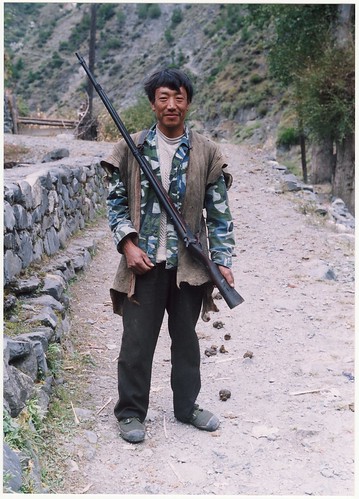
"The climate here is too warm for people to wear traditional Tibetan clothes" said Zago. The only item of clothing Joseph Rock would have recognised were the homespun yak hair cloaks with wide red seams that some men still wore.
Further down the valley, we were suddenly brought up short by huge boulders blocking the road ahead. As we slowed to tackle this obstruction another large chunk of rock bowled across the road ahead of us. I looked up to see about twenty Tibetan faces peering down at us over the rim of a cliff a hundred feet above the road. I had visions of being attacked by tufei (bandits) - but Zago assured us this was just the local way of quarrying for building materials.
Not expecting any traffic along this rough trail, the locals had been dislodging large boulders to roll down across it, without giving thought to what lay below. After a few minutes of grunting work to shift the boulders under the curious stares of the locals, we were on our way again.
A few more miles further on we paused at the large village of Sanyanlong - a veritable metropolis - where there were a couple of stores, a clinic and a sizeable, neat Chinese-style school. The students flocked out to see us, and Zago, being director of education, went in to make a quick visit.
I popped my head into the clinic, a simple treatment room where a demur female doctor in a white coat was inserting an IV drip into a woman's arm. "Conditions here are very poor," she said apologetically.

I recalled Rock's 1929 comments:
"Whenever we came to a village the peasants would gather about us and with folded hands would beseech me to dispense medicine to sick relatives. Often I could help. Sometimes I had to refuse".
At least now they had a clinic.
By mid-afternoon we had reached the end of the road - Shantien.
This was Zago's home village and there were many happy shouts as we parked the Landcruiser and aunts, uncles and cousins emerged to be reunited with their relatives from town.
From the courtyard where cows and pigs grunted, we climbed up steps hewn out of a log up to the first floor of balcony of his ancestral timber-framed home. Inside the roomy interior we had a late lunch of fatty bacon and some bitter courgette type vegetable. On the walls were the usual gallery of framed family pictures, but also an old hand-coloured photograph of a meeting of the Dalai Lama and Chairman Mao.
And of course, everyone slurped bowls of suyou cha - butter tea.
"My dad's brother is a well known huofo (living Buddha)" said Zago pointing to a picture of another maroon-clad benign-looking monk. It seemed quite normal to have a Communist official and a leading member of the Buddhist clergy in the same household.
During the meal a toothless local man brought in an old flintlock rifle similar to one portrayed in one of Rock's photographs.
I was also shown other historical artefacts - an old chest containing bricks of tea - once this was a stopping point of the tea and salt caravans between Yunnan, Tibet and India. There was also a huge rounded coffin, prepared in advance by Zago's uncle. It was a Han style coffin, he told me, without any trace of morbid feeling. Tibetans are buried in a sitting position, Zago told me.
He took me up to the roof of the house, strewn with dried out maize stalks, a sweet pink form of barley called mocheng mian and flat wicker trays of red peppers to point out where we would be going. At the bottom of the valley was a large pointed peak called Sazanran, to the right of which flowed the Yangwe Kong river down a cleft towards the Yalong river.
"We're going over that" he said. It looked impossibly steep.
Later on the Joseph Rock photographs came out again, and everyone crowded around to see their old villages. Zago's uncle looked at the one of Mundon and asked:
"How does the foreigner have pictures of our old village when even we don't have them?"
The big ascent to Mundon
The sounds of clanking bells heralded the arrival of our horses for the next part of our trip. The four horse handlers strapped on our bags, adjusted the stirrups and straps and we were soon setting off up a steep rocky trail behind the houses through the bushy hillside.
Almost at once the handlers were urging me "Qi ma , qi ma!" (Ride the horse). At first I tried to walk but as the altitude took a toll I soon conceded and let the horse sweat its way more surely up the narrow and zig-zagging trail.
As we ascended, an impressive view of the lower half of the Yangwe Kong emerged, along with a bird's eye view of the narrow cleft of a gorge that lead down to the Yalong river, far below.
"Why did Rock take the trouble to climb all this way over the hills when he could have just gone down to the river there? I asked Zago.
The simple answer was there was no place to cross the Yalong at that point and no settlements on the steep sides of the canyon there.
"This is the only way to cross to Muli and Yunnan," he said flatly.
Our track eventually crested and crossed over a cleft in a razorback ridge of Sazanran, to descend equally steeply to some more settlements in a beautiful steep sided valley on the other side. I marvelled at the deep green tones of the precipitous slopes, and the surrounding ridges that hung like crenulated brocade. But what an isolated place it was! With its steep enclosing valley walls, this was surely the place that Joseph Rock described as having "no outlook in any direction", and where he thought it was so oppressive "to be buried alive in these vast canyon systems!"
We dismounted, drank the clear water from mountain streams and we went down, passing a few isolated farm houses on our rollercoaster descent only to begin another weary ascent as the day drew to a close.
For hour upon hour, up and up the poor horses strained, by now needing constant urging from the handlers as they paused every twenty steps, panting and sweating. "Cho! Ra-cho!"
After numerous false summits, it took what seemed like hours before we were able to "fang shan" (reach the top of the mountain). When we did, it was dark. We were on top of a rounded ridge overlooking the Yalong river canyon. Even in the fading light, it was very impressive. Down there far below, somewhere in the gloom, I could just make out a few faint pinpoints of orangish light far below, presumably houses along the river bank in Muli county across the river. Above, a crescent moon cast a little illumination to guide us further up the ridge.
The horses stumbled on up the ridge track. By now I could barely make out the track and I wondered how the horses could see where to put their feet. I was glad I could not see the steep drop that I would face should the horse stray off the ridge. It was a surreal and marvellous experience to be riding under the faint moonlight, with the canyons far below and the long jagged ridge of the Muli mountains opposite marking the divide between earth and the night sky.
An inverted carpet of stars and the Milky Way lay above our heads. Saddle sore and worn out from the day's ascent from the remote Yangwe Kong valley, I strained my eyes to look for any sign of a settlement. The only lights were those faint pinpoints far below, across the Yalong river canyon, in distant Muli county.
The only sound was of the horse bells clanking and the occasional "Cho!" to stir them on from the handlers, shadowy figures who could only be seen by the orange glow of their cigarette tips.
Some time around 8pm we finally saw a faint pinpoint of light ahead. Mengdong!
We came upon a cluster of shadows - buildings? In the darkness we gathered outside the locked wooden gate of a Tibetan house on the hillside, and an incredulous old man's voice from within eventually replied to shouts from Zago and the handlers. A dog barked, a faint light went on inside and a torch shone out in our faces.
The old man mumbled the Tibetan acknowledgement of "Oh-ah-uh" and let us in.
Hauling our weary saddle-sore limbs up another notched log from the muddy courtyard, the handlers took care of the horses. Within the smoky dark scullery we huddled around a wood fired stove as Pema's uncle cooked us a late dinner of fatty yak meat, boiled potatoes and sour yoghurt.
This was the house of Pema's father and uncle and they had a lot of news to catch up on. Recognising that the foreigner could not stomach much of the tough yak meat, they made me some roast potatoes by burying them in the ashes of the fire. I sat in the dark by the fire, peeling the potatoes with my fingernails and eating the insides with a sprinkling of chilli flakes.
The villagers pored over the old photographs that I had brought with me.
Zago's grandfather told us he well remembered the visit by Joseph Rock to their village. He recounted the story of how as a five year old he had been intrigued by the silent foreign visitor, and had been very curious to hear how he spoke. So when Rock had bedded down for the night, the young kid and his older brother dropped a few dried leaves near his bed and set fire to them to see what the visitor's reaction would be. Unfortunately, their ruse worked better than expected, because the flames from the burning leaves set fire to Rock's sleeping bag. The westerner jumped up and started yelling at them, as they scarpered outside to hide behind a nearby bush. Rock spent much of the next morning in angry silence, sewing up his sleeping bag.
Grandfather had another Rock anecdote. Later on during Rock's visit to Mundon, when the young lad was acting as a guide to the botanist, grandfather claimed he had tricked Joseph Rock out of his camera. He said he had spied the strange equipment hanging up unattended on a tree branch, and he hid the camera in some bushes. Joseph Rock became distraught when he could not find his precious camera and paid a handsome reward it was "found" by the young uncle. Grandfather remembered that Rock was so relieved to get his camera back that he actually kissed it when he had it back in his hands.
However, the unworldly young Tibetan kid was not to profit from his trickery. Unaware of the high value of the silver dollars he had received from the foreigner as a finder's fee, he said he was later tricked into exchanging them for just a few pieces of working clothes by a trader in Muli.
Perhaps it was the altitude, but I felt dozy and dizzy and lay down on some yak hair blankets on the floor, pulling my sleeping bag around me. The walls of the room were covered in posters of "Distinguished Animals and Birds of Ganze Prefecture" and an official notice with a Tibetan monk on that pronounced "This is a Safe and Civilised Household".
The others soon joined me to bed down on the wooden floor.
"If it wasn't for me you'd still be here digging up spuds," Zago teased Pema in the dark.
"If it wasn't for you we'd have been here half a day earlier. You're so fat your horse needs a rest after every five steps," Namu teased her father.
Muti Konka (Maidi Gangga 麦地贡嘎): the mountain with a monster legend
The following morning I rose before the sun came up, from among a pile of snoring bodies in the wooden room. Our party of eight had quite taken over the Mengdong uncle's house. Tottering round in the cold, with my legs and thighs still aching from the previous day's long hours in the saddle, I somehow managed to find a flask of hot water (kaishui) to wash with and put my contact lenses in.
At the time of Rock's visit there had been no water here at all. It had to be "carried by the women from a thousand feet below".
This time there was a little, thanks to a diverted mountain creek, enough to make a weak cup of Nescafe to warm me up as I stood on the balcony and watched the sky lighten and reveal the Muli mountain ridges. To my surprise the string of lights I had seen the night before were not houses along the river, but belonged to a settlement only half way down the canyon. This really was a massively deep gorge!
As the others began to rise, Pema's cousin, a rugged but cheerful looking Tibetan, climbed up from the cow yard clutching a flapping chicken by its legs.
"Morning!" he hailed, and pulled himself out a stool to sit on. Before I could react he had slit the bird's throat and was directing a stream of steaming dark blood into a bowl as casually as if he was pouring red wine from a casket. I moved away as he efficiently started to pluck and wash the now lifeless carcass, which was a very unappetising greyish white colour.
Joseph Rock described Mengdong (Mundon) as a "dreary Hsifan hamlet". But as the morning sun rose over the peaks it seemed to me anything but dreary. The views across the gorge were superb and this collection of four family houses seemed to be a cheerful little community.
Drawn by the sound of chanting and the throbbing of a drum, I visited the small Black Hat Buddhist temple next door, outside which in a stone shrine some burning juniper branches sent up a trail of smoke into the blue sky.
Within the dark and dusty interior a couple of old men in ordinary clothes were conducting a morning blessing, impervious to a young boy and girl toddlers who gamboled around them. The bumpy surface of the whitewashed interior wall was covered with colourful Buddhists frescoes. On an exterior wall at the entrance there were more beautiful pictures of Buddhists figures in delicate faded sky blues, yellows and pinks. All their faces had been scratched off during the Cultural Revolution.
"Tai yihan" (What a pity) said Zago, by my side.
Back in the house there was a shout of "Breakfast!" and the whole household and visitors were soon slurping bowls of fresh chicken stew with potatoes, bones and all.
We were farewelled from Mundon/Mengdong (猛董) mid morning by all the four families of the hamlet, many of them dressed up especially in their finest Tibetan clothes. We posed for a few portraits, and then it was time to depart.
Again I tried walking up the trail, but even a short stroll up the relatively easy slope left me breathless. I remembered we were close to 4500 metres high.
"Qi ma!" urged the horse handlers, and I quickly complied. "Without horses you'd have no chance of getting to here," said Zago.
And as Rock had noted:
"Merely walking or climbing over a steep trail at heights of 16,000 feet is difficult enough, without carrying 80-100 pounds on one's back. This feat was performed by the Hsifan peasants through fear of our lama, who represented the Muli king ..."
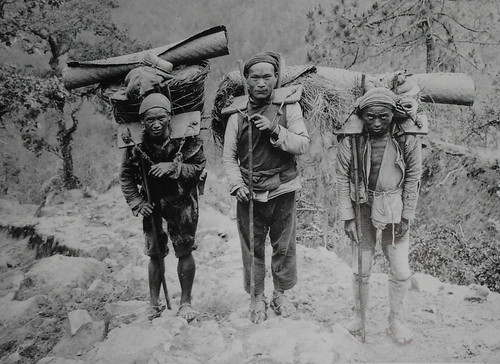
This time it was our horse handlers who bounded up the hill in frayed plimsolls. Their singing of Tibetan songs seeming to grow louder and more enthusiastic as we climbed higher. Perhaps it was to do with the amount of Ara - spirits distilled from maize - that they consumed. By the afternoon they reeked of it.
We ascended up the ridge, gaining fine views of Mundon from above, through fir forest that was regenerating from a 1984. In parts, whole swathes of the mountainside had been denuded of trees, while others seemed untouched.
Ahead we could see the high ridge of the Wadzanran pass, and Pema warned that if it rained we would likely see many wenxue (leeches) emerging. "As big as fish some of them are," she commented.
But the weather stayed fine and clear. We reached a plateau and clearing, ideal for camping, where the horses rolled on the grass and we had fine views in three directions: to our right the serrated ridges falling gradually to the Yalong river and rising again in Muli county. To our left were the ridges that trailed off into the Yangwe Kong. And ahead was the Wadzanran pass.
"That's where the bandits used to lie in wait for the mule caravans that came up from Yunnan," said Zago. "They were bad guys - you wouldn't want to meet them!"
By now, peeping above the crest of the brown grassy hill ahead was the tip of a snow peak. "That's Muti Konka!" exclaimed Zago. It was frustratingly near but I could see little of it.
After our break we continued, skirting around the left hand side off the rounded ridge we were ascending, seemingly away from the Wadzanran pass.
When I expressed my doubts, Zago told me:
"We aren't going up to the pass - I've got something better to show you. Something Rock missed."
And as we rounded the ridge, suddenly the whole length of the Muti Konka ridge came into view. And what a sight its snow covered heights were. As well as the majestic main peak, there was a second snowy dome and in front of it a rocky knob, not covered by snow.
"Muti Konka is the yak spirit mountain," Zago told me. "The peak there is its horns, this ridge is one leg and the Wadzanran ridge is another leg. The pass is its knee," he said.
The rounded second peak, Jachong, was Muti Konka's wife and the rocky knob, named Yandron Zemu, was its little sister, he explained.
There was even better to come. As we continued around the hill, suddenly the lower reaches of the mountain slopes came into view. And there, far below us lay the most perfect alpine lake, kidney shaped, with much of its length hidden from view behind the forested arm of a descending ridge.
On its near shore was a grassy plain where several tiny houses could be made out. It was like a scene from old Switzerland.
According to Zago, the alpine lake beneath Muti Konka was known as Zuni Ho to the Puma, or Chang Haizi [Long Lake] in Chinese. We sat down to have a rest and one of the horse handlers, a gentle older man, told us of the legend of a monster in the lake's depths. He recounted how he himself had seen something splashing around under the surface of the lake some twenty years ago, and the large waves it had created on the shore. It was hairy, with the head of a horse, he said, matter of fatly, sucking on his cigarette. No one doubted him.
Lonely life at Chang Haizi
We descended steeply though forest to the grassy clearing in front of the lake, and were welcomed by one of the two yak herding families who made a living there. As his dog barked at us, Mr Champei invited us into his primitive house made of grey boulders. Inside the timbered interior it was surprisingly light and airy - quite a contrast to the mucky darkness of Mendon's dwellings.
As we settled down for 'suyou cha', I looked around and wondered, like Rock, how these people coped with the isolation. But even here, two days hard horse rise from the nearest dirt track, they had electricity from a distant hydro power station. There were light bulbs and a dusty old hi-fi player.
And as with all Tibetan houses, they had a picture frame on the wall, filled with family photographs. Some of the older ones were of the family in quilted PLA-style uniforms - from the 1970s. The more recent ones showed them on excursions to the Big Buddha at Leshan, down in the Han-dominated Sichuan lowlands. These were not people cut off from the outside world any more.
We settled down around the central fire, above which was suspended a wicker basket from which hung black entrails of condensed grease and soot. Inside the basket were mounds of cheese. A yak's skull decorated with motifs like tattoos took pride of place on the mantle piece and the lady of the house was soon preparing butter tea in the usual way using a plunger to squish a mixture of tea and liquid butter up and down inside an elongated wooden bucket.
For our dinner she first prepared Yumi Momo (maize bread) by cooking the maize dough in the ashes of the fire. While that was baking she took out a black old kettle that appeared to have noodles inside. It was actually yak cheese, congealed on lengths of tree twigs that had been put inside the kettle. She unwound some of the stringy cheese and mixed it with green peppers to make a kind of macaroni they called gyedon, or xiulai, in Chinese. This was complemented by more fatty yak beef and thin strips of fried potato stir fried with chillies.
Namu, the big city student, surprised me by her quick adaptation to our primitive surroundings. I had been misled by my initial impressions of her pouting mannerisms and constant fiddling with her mobile phone. I had expected her to be squeamish in this environment, but she was obviously born to it. Looking incongruous in her trendy city clothes, she expertly built up the fire, served up the tea and bantered with one of the young Tibetan horsehands, Tsemi. He seemed to be a bit of a jack the lad, but his ribald conversation and jokes kept everyone enthralled throughout the evening.
A bottle of ara (maize) spirit was passed around, and Tsemi was a good mimic: there was some joke about mispronouncing jiujiu (uncle) that had everyone in fits. Pema laughed until she choked, and I reflected it was a long time since I had heard such unrestrained laughter. I felt a bit left out.
The toilet arrangements were simple - you just went outside somewhere, not too near the house or the lake. In the darkness I wandered some way off and turned off the torch. It was almost completely black except for the overarching white presence of the mountain, like two arms of a ghostly cloak around the lake. I couldn't see the house at all, and I panicked. Without a torch, I felt that even from a few yards away I would not have been able to find the house again.
Back inside, I settled down in a dusty corner and fell into a fatigued sleep to have strange and vivid dreams. Was it the altitude or something else at work?
[2024 UPDATE: You can now see a video of this area with drone shots taken by visiting Chinese hikers]
Visiting the relatives at Roni
There was frost on the ground as I emerged from the boulder shack and saw Mrs Champei milking a yak with a bright green plastic bucket.
Above reared Muti Konka, still in shadow as the sun had not yet reached over the ridgeline. We were meant to have an early start but the horses could not be found.
While the others breakfasted on suyou cha and tsampa, I walked down to the lakeside. The water was crystal clear, showing the blue-grey stones on the bottom, receding into pale sandy depths. The surface of the lake was absolutely still, and appeared to be covered with a fine coating of dust.
I witnessed an unusual and startling visual effect. When the sun's rays first appeared over the ridge, the surface of the lake became a perfect mirror reflecting the snowy mountain and autumnal forest colours of greens, yellows and reds and browns. However, as soon as the sun's rays directly touched the lake, the mirror reflection was instantly and dramatically transformed into a window, revealing the sparkling perception of its depths.
I threw in a small pebble and watched the concentric rings of its ripples swimming and expanding as shadows on the bottom of the lake. If there was a monster down there it must be keeping very still, I thought.
I went for a short stroll along a trail up the hill behind the boulder shack. In the early morning sun the unfolding panorama of Muti Konka - or Maidi Gangga (麦地贡嘎) in Chinese - was magnificent. I was soon out of breath and paused after a few hundred metres to look down over the lake to survey the beautiful scenery. It was a sublime spot, and I wondered how many other outsiders had visited this place since Rock's time. And why had Rock not taken any photographs of this stunning peak?
My silent thoughts were interrupted by the distant clanking of bells. The horses had been located and when I returned they were chomping at their nosebags of maize and being readied for the days exertions. Bags were strapped on, the wooden saddle frames covered with itchy yak hair covers, straps were tightened and then it was "Zou ba!" - let's go!
It was another perfect clear sunny day as we farewelled the Champei family to return to Sanyanlong by a different route, via the village of Roni (Lawaling in Chinese). We first headed downhill into forest of firs and yellow leaved Qinggan shu whose branches were festooned with a hanging lichen known as old mans whiskers or muliusiu. Birds flitted around in the undergrowth and bell-like blue flowers – qiuhua - paved the occasional clearings.
"You should come here in June when the azaleas and rhododendrons are in bloom," Zago told me. Later on, down the trail, he suddenly urged us to be quiet and we dismounted. Creeping forward he pointed to a flock of large grey quails, which suddenly darted off into the bushes with much clucking and flapping. Ye-ji (wild chickens), he laughed.
And as we ascended a ridge opposite the Wadzanran pass he pointed out the songron mushrooms growing by the wayside. "Good for cancer. Japanese pay a lot of money for them - but we don't have time to stop and look for them," he sniggered.
It was a leisurely day's ride up through sunlit forest until we eventually crested the hill at lunchtime, and stopped to admire the view back to the Wadzanran pass, and away over to Muli.
"It looks so close but it would take you half a month to climb down into the gorge and back out again," said Zago. "They used to do it in the old times, but why bother now? You can drive there in a day from Jiulong ..."
Zago and the handlers spent a half hour searching for and eventually spotting a pusa (religious image) of Kuanyin painted on the summit rocks high above us. Then we descended through the forest until we suddenly emerged above a neat village, situated on a flat platform of land at the end of the ridge, high above the Yangwe Kong valley."
"This is Roni," said Zago. "They are all family here."
In the afternoon sun a couple of men were ploughing a furrow through a potato field with a unruly yak. An old man in a tattered grey cowboy hat waved us over. It was Zago's uncle. There was much to talk about, he hadn't seen his relatives here for five years.
Down in the village proper, among the stone and dark brown timbered buildings, we were ushered as guests of honour into the comfy chairs of the main room. We sat amid an odd mixture of farming implements and DVD players as the head of the house – Zago’s cousin - rounded up the older relatives to drink tea with us. He wore a red silk Chinese waistcoat decorated with circular celestial motifs and an upturned Desert Storm-style bush hat on his head. Zago had to restrain him from killing a goat for us, so the cousin compromised by have his son to chase two unfortunate chickens over the walls and roofs of the cow shed, to be consigned to the pot.
While Zago caught up with the family gossip, everyone wanted to have their photograph taken with me, and have their formal portraits taken.
I was taken on a tour through the old village to meet an old lama and see his corner of a house where he made pious supplications to Buddha while a vicious dog in the yard outside lunged and barked at me in seemingly rabid intensity, threatening to snap the home-made chain.
Over another chicken and potato stew the 83-year old grandma, Yanzhong Lamma, told me how she remembered the visit of Rock and his strange entourage. He brought strange accoutrements like photographic plates and binoculars they had never seen before, and her father had the honour of guiding him over the hills to Jiulong.
In an echo of this, the younger people of the village marvelled at my LED torch and cooed as they stroked the plastic Australian dollars they asked to see.
Before leaving, Zago pressed a 100 yuan note into the protesting hands of his aunts and uncles and we headed off, past old timber-framed buildings with iron tridents protruding from the rooftops and the yellow painted stone swastika motifs embedded in the walls. We passed a stand of old ash trees with a sweeping view of the Yangwe Kong valley, and began the last descent back to Shantian.
It was soon pitch dark and what little of the moon there was remained hidden by the ridge. I was glad of my torch because its little beam lit the way for us, down a steep track alongside a roaring but invisible series of waterfalls.
As we paused in the dark, on a narrow terrace above the valley, I asked Tsemi about what Rock had written.
"This place is cut off from the outside world - do you feel happy here? Would you rather be somewhere else?"
In his nasal Sichuan accented Chinese he confidently and matter of factly dismissed the idea.
"We've got everything here - good food, nice people, good weather and all this beauty - and plenty to drink. Why would I want to live anywhere else?" he said.
There was silence for a while as the others contemplated what he said. The tips of their cigarettes glowed in the dark.
"Do you think you will you come back here?" asked Tsemi.
"I hope so," I replied.
The next day after we had rested at Zago's house I received a rapturous reception at every place we stooped on our bumpy journey back up the Yangwe Long. The local Pumi people greeted me as if I had just returned from the moon. "Xinku! Xinku!"(hard going, well done!) they said, smiling from ear to ear.
At unscheduled stops I was plied with Qingke Jiu (barley spirits) and toasted endlessly. I was taken on a tour of the local school, and treated as the guest of honour.
One of the local female teachers ushered me into a room where most of the staff had been hastily assembled. With trembling hands she held a glass of qinke jiu (barley spirit) up in front of me and sang a high pitched, ululating Pumi song of welcome, then draped a traditional white kata scarf around my neck.
"Welcome to come back here, please tell everyone about our little place," she said.

















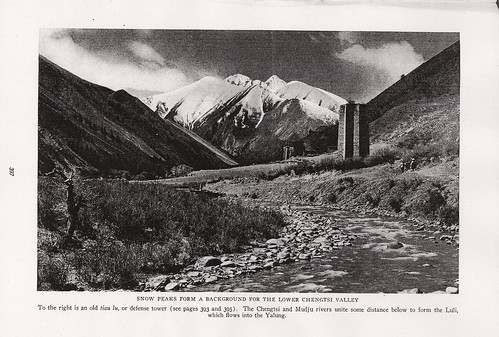















































































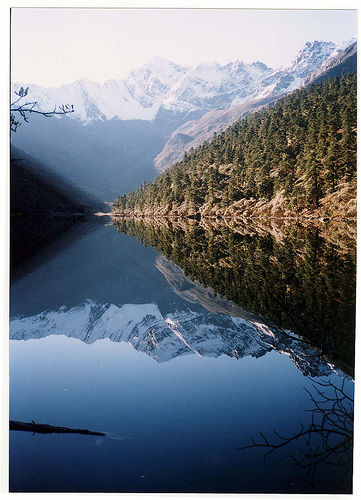















11 comments:
so wonderful, to have followed this series .. you have a very heart-centered writing style. hope to encounter it again.
Thanks Gregory.
I just came across your blog while looking out for Rock's "Glories of the Minya Konka". My grandfather explored the Minya Konka shortly after Rock, in the summer of 1930. He has published a book about this expedition in 1976. He was a wellknown geodesist and cartographer, his name was Eduard Imhof
oh, maybe you're interested in the pictures he took and painted. Here's the link:
http://www.nzz.ch/nachrichten/panorama/minya_konka_expedition_1930_1.7119171.html?video=1.7474870
Thanks Isabelle - yes I noted your grandfather's contribution in my post on the Minya Konka region here:
http://drjosephrock.blogspot.com/2011/03/chapter-5-gongga-shan-glories-of-minya.html
His sketches are very beautiful.
Thank you, I didn't get that far, yet (reading your blog, that is).
it's an amazing blog! I really enjoyed to read it. Photos are fantastic. Thanks for sharing this experience!
Hi Michael, just back from my Kangding -Jiulong trip. Wonderful area and (so far) unspoilt. Great to read your adventures.
Cheers Harry (jansalpines.com)
It's amazing to find your blog here and know that you have done what I dream to, Especially when noticed that Isabelle's grandfather is Eduard Imhof! That's really excited
I'm a Chinese student/climber in a university located in Sichuan, and I have concentrated on exploring ranges, mountains and valleys in Western Sichuan for several years
Researching and reading on such subjects let me know Joseph Rock, Eduard Imhof, Richard Emmons, Arnold Heim(explored Konka in 1933) and so on. But sadly I found no translations of them in Chinese, actually few Chinese climbers actually know their stories and have read them, their books are also very hard to get in China.
It's ironical especially in my country that people even know less than their foreign friends from America or Europe about what used to happen on such great peaks and valleys that now have become tourist spots quite famous to themselves.
Thanks Radium! I especially recommend the book East of the Himalaya by Tamotsu Nakamura (see my previous post on this book) -it has all the photos and maps of every mountain in the region!
Experience the Best Prime Leather Jacket USA– a perfect blend of luxury, durability, and timeless style! Crafted from premium leather, our jackets offer unmatched comfort and sophistication. Whether you prefer a bold statement or a classic look, the Best Prime Leather Jacket USA ensures you stand out with confidence. Elevate your wardrobe with quality that lasts!
Post a Comment